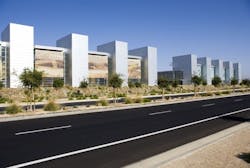Desert Museum is an Energy-Efficient Oasis
HEMET, CA - The 70,000-square-foot Water + Life Museums, which comprise the Center for Water Education and the Western Center for Archeology and Paleontology, were designed to meet the most exacting green standards (including those regarding energy and water consumption), despite the harsh desert environment of Hemet, where triple-digit summer heat is the norm but where water can freeze in winter. The complex is the first museum building to secure a Platinum LEED rating.
The $40-million Water + Life campus won critical acclaim for its structures and 17-acre campus, where indoor and outdoor spaces mix within a framework of airy floor plans and abundant natural light. Additional awards for the twin desert museums include the Beyond Green High Performance Award from the Sustainable Buildings Industry Council; the AIA Pasadena/Foothill Design Honor Award; and two Gold Nugget awards (Best Sustainable Commercial Project Grand Award and Best Public/Private Use Facility Merit Award).
"The museums are topped by one of the largest solar-panel installations of its kind," said Mark Gangi, AIA, principal, explaining the 540-watt, 3000-panel photovoltaic installation that provides the complex with nearly half of its total power needs. The solar panels also shade the roof from desert sun, while special translucent panes provide dappled light to outdoor loggias.
Other green elements include translucent banners that hang across 8,000 square feet of deeply recessed, east-facing glass to both identify the museums as well as mitigate the desert sun. Thanks to heat-blocking glass, the windows also let in abundant natural light, minimizing artificial lighting needs. Interior lighting, when needed, is controlled by a network of electronic sensing devices and timers that optimize daylight harvesting. Heating and cooling are conducted through a sophisticated mechanical system of radiant flooring and forced air units.
Like proud sentinels, five 40-foot-high brushed-steel towers front each museum's façade, standing tall against the azure desert skyline. Monolithic, the towers evoke the minimalist sculpture of Donald Judd, while the repeating forms suggest the industrial triumphs of the museums' prime benefactor, the Metropolitan Water District of Southern California. The museums are surrounded by desert gardens featuring native and drought-tolerant plants that are sustained by state-of-the-art drip-irrigation systems that use reclaimed water.
